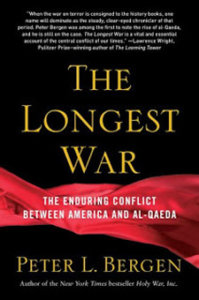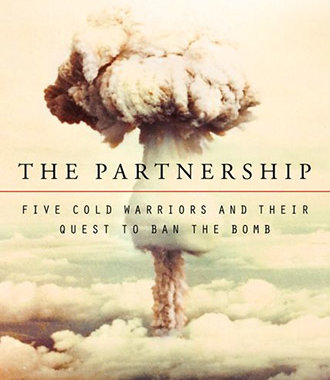
IndieBound
Osama bin Laden, the instigator of fetishized violence as practiced by al-Qaeda and its allies, was the prime target of the address President George W. Bush gave to both houses of Congress on September 20, 2001, nine days after 9/11. In his address, President Bush used the words “war on terror” publically for the first time: “Our war on terror begins with al-Qaeda but it does not end there. It will not end until every terrorist group of global reach has been defeated.” The “war on terror” was not merely a term of description but a pre-emptive strategy that would set the course of foreign policy for the next ten years. President Bush, it seemed, was doing double duty: warning the terrorists of the fight to come, and reassuring an audience of traumatized Americans that his administration would conduct the “war on terror”—however open-ended and ambiguous—in other countries in order to keep Americans safe in their own.
Peter L. Bergen has written a comprehensive, analytical, and trustworthy account of the “war on terror” in his book; The Longest War: The Enduring Conflict Between America and Al-Qaeda. Promising “to tell a history of the ‘war on terror’ in one volume,” Bergen covers 9/11; bin Laden’s jihad against the United States and the West; the necessary war in Afghanistan and the unnecessary war in Iraq; bin Laden’s escape from the craggy ridges of Tora Bora into Pakistan; the Bush Administration’s policies of enhanced interrogation and extraordinary rendition; Pakistan’s ambivalent role in the Afghan war; al-Qaeda’s successful use of the internet from bin Laden’s hideout in Pakistan; President Barack Obama’s winding down the two wars; and bin Laden’s death in Abbottabad, Pakistan, after ten years on the run.
In this narrative history, Bergen “also aspires to provide an analytical net assessment of the ‘war on terror,’” and he builds a methodical framework to fulfill this promise. The Longest War has two parts. In the first part, “Hubris,” Bergen “traces al-Qaeda’s miscalculations,” in particular bin Laden’s mistaken belief that the United States was a paper tiger and would not retaliate after the attack on 9/11, and he interweaves “the strategic missteps of the United States from its initial anemic efforts in Afghanistan to its counterproductive invasion of Iraq.” In the second part, “Nemesis?”, Bergen “traces how the American government and the military learned from their mistakes in Iraq and, later, Afghanistan,” and he shows how the United States regained the advantage over al-Qaeda, while “bin Laden and his followers severely damaged themselves with their actions in the Muslim world….”
Throughout The Longest War, Bergen effectively interconnects the content of each chapter in “Hubris” and “Nemesis?”, while also writing analytical assessments that eventually add up to a provocative insight: The United States and al-Qaeda “has made a set of symbiotic strategic errors that has helped the other.” For example, in “Hubris,” Bergen writes: “…the Bush administration would set the course of policies that would have unforeseen consequences for many years into the future: a ‘light footprint’ operation in Afghanistan, which would succeed brilliantly at toppling the Taliban but leave many of the top leaders of al-Qaeda at liberty following the failure to capture or kill them at the battle of Tora Bora in December 2001, and would also fail to secure Afghanistan for the long term. Bush also launched the nation on an ambiguous and open-ended conflict against a tactic, termed the ‘war on terror,’ which would warp U.S. foreign policy and distort key American ideals about the rule of law, while his administration’s obsession with Iraq would lead the United States into fighting two wars in the Muslim world simultaneously, seeming to confirm one of bin Laden’s key claims—that the West, led by America, was at war with Islam.” This sharply focused analysis is one among many of Bergen’s critical assessments on the “war on terror,” exemplifying his deep understanding of the decade in which thousands of soldiers from a multitude of nations, including from Iraq and Afghanistan, have lost their lives; thousands more have been wounded; and many thousands of Iraqi and Afghani civilians have been killed. In addition, the United States has spent more than two trillion dollars on two wars, homeland security, and counterterrorism. (This figure does not include nearly a trillion dollars in future war funding between 2012 and 2016 and the future care for veterans.)
Bergen is as trustworthy an author as you can get, especially about the events of a decade that are so deeply politicized, such as: bin Laden’s escape from Tora Bora in the winter of 2001; the discredited links between Saddam Hussein and al-Qaeda; the false claim of weapons of mass destruction in Iraq; the transfer of military resources from Afghanistan to Iraq; the efficacy and legality of enhanced interrogations, waterboarding, and extraordinary rendition; implementation of the “surge” in Iraq in 2007 and in Afghanistan in 2009 and its success in both countries; and President Barack Obama’s commitment to withdraw forces from Iraq by December 2011 and from Afghanistan by 2014. Bergen’s arguments are true and valid, especially when he examines the roles Osama bin Laden—the central figure interlocking 9/11, the wars in Afghanistan and Iraq, and the demise of al-Qaeda with his death—and President Bush played in the “war on terror.” In a synthesis that is just short of remarkable, Bergen uses “all the available open-source materials,” together with his own interviewing and reporting “during the course of more than a dozen visits to Afghanistan and Pakistan,” including interviews with people from all sides of the war: “failed suicide bombers; leading Western counterterrorism and national security officials; members of the Taliban; the family and friends of Osama bin Laden; top American military officers; victims of American ‘extraordinary renditions’…leading members of al-Qaeda, including bin Laden, and former militants who have turned against bin Laden’s terrorist organization.” Indeed, Bergen has thoroughly assimilated his sources: There are five pages of the names of interviewees in small print; seventy-eight pages of notes; fifteen pages of bibliographical citations; and three pages of acknowledgements.
Informative, descriptive, explanatory, disciplined, and never boring, The Longest War begins with 9/11—the men who planned and carried out the attacks on the World Trade Towers and the Pentagon (and failed in their mission to attack the United States Capitol), which they dubbed “Holy Tuesday”—and al-Qaeda’s assassination of Ahmad Shah Massoud, the guerrilla commander of the National Alliance, enemy of the Taliban, and friend of the United States—to get him out of the way before the attack on 9/11. Bergen then lays the foundation to understand bin Laden and his motives to bring down the United States: He describes and identifies the influence of Islamic scholars on bin Laden’s fundamentalist beliefs and the trajectory of bin Laden’s career from a “monosyllabic millionaire with the open checkbook” to his subsequent recruiting and subsidizing young Afghan mujahidin to fight the Soviets in the 1980s; his transformation from businessman to Mujahid or Holy Warrior; his founding of al Qaeda, “the base,” in 1988; and his ultimately building al-Qaeda, “arguably the most organized terrorist group in history,” into the infrastructure for his grand project—the transformation of “the Muslim world into a militant Islamist caliphate” stretching across the globe. If he accomplished his dream, he would be its emir.
Believing he was the 20th century Prophet Muhammad and the chosen one, bin Laden was obsessed with defeating the superpower America—the country that obstructed his goal. Throughout the 1990s, bin Laden warned the United States that he had it in his sights. Who could mistake the meaning of the radical statement he issued in 1996 from his mountain stronghold of Tora Bora in Afghanistan: “Declaration of War Against the Americans Who Occupy the Land of the Two Holy Mosques”? From his perspective, the Americans troops stationed in the Persian Gulf region, as well as its support of Israel, were offenses no Muslim could tolerate. He called for armed struggle against the infidels, and in 1998 he “issued the edict calling for attacks anywhere in the world, declaring it an ‘individual duty’ for all Muslims.” (NY Times, May 3, 2011) As Bergen explains: “Bin Laden’s main goal was to bring about regime change in the Middle East and to replace the Arab governments with Taliban-style rule. He believed that the way to accomplish this was to attack the ‘far enemy’ (the United States), then watch as the supposedly impious, U.S.-backed Muslim regimes he called the ‘near enemy’ collapse.”
Bergen should know something about bin Laden. In 1997, as a correspondent for CNN, he traveled to Afghanistan to produce bin Laden’s first television interview. During this interview, “the Saudi militant told a Western audience for the first time that he was launching a holy war against the United States.” As Bergen writes: “Conceptualizing the United States as the Main Enemy was also useful for bin Laden because it was a big enough idea that it could unite several militant Islamist organizations with purely local agendas…under al-Qaeda’s banner as the standard-bearer of Global Holy War. And it had a further benefit in that it blamed America rather than the jihadist organizations themselves for their failures from Algeria to Egypt to mobilize genuine mass movements capable of toppling authoritarian regimes in the Middle East.” Bin Laden’s youthful piety had become a fanatical obsession with the West, the United States in particular. 9/11 was the most dramatic result of this obsession, but Bergen claims that bin Laden failed in his goal of bringing the United States down: “For all his leadership skills and charisma, however, bin Laden accomplished the exact opposite of what he intended. A decade after the September 11 attacks, his last remaining safe havens in the Hindu Kush were under attack, U.S. soldiers patrolled Afghanistan and Iraq, and he was dead.”
Bergen’s assessment that the 9/11 attacks were the climax of al-Qaeda’s campaign against the United States, not the beginning, seems counterintuitive. In the ten years since 9/11, al-Qaeda, its affiliates and franchises, and “leaderless cells” have perpetrated multiple terrorist attacks around the world. Bergen summarizes: “The 7/7 London bombings [July 2005] were carried out by an al-Qaeda-directed cell; the bombings of two nightclubs on the Indonesian island of Bali in 2002, which killed some two hundred mostly Western tourists, were the work of Jemaah Islamiyah, al-Qaeda’s Southeast Asian affiliate, and were the most deadly terrorist attack in the history of the world’s most populous Muslim country; the bombings in Istanbul a year later [November 2003] that killed sixty-two were directed by al-Qaeda; the most protracted suicide bombing campaign in history, in which thousands of Iraqis were murdered, was largely conducted by al-Qaeda’s affiliate in Iraq [Al-Qaeda in Iraq led by Abu Musab al-Zarqawi]; and the wave of suicide attacks in Pakistan that killed many hundreds after 2006 was carried out by groups allied to or inspired by al-Qaeda.” In addition—and most notably—there were the 1998 embassy bombings in Kenya and Tanzania; the suicide attack on the USS Cole in October 2002; the multiple bombings on Madrid’s transportation system in March 2004 that killed 191; and the attacks in Mumbai in November 2008 by the militant group Lashkar-e-Taiba, an al-Qaeda spin-off, which killed 170 people. Although this radical terrorism numbs the mind, it would have been far worse if bin Laden had not been hiding in Pakistan, unable to plot attacks as destructive as 9/11. Bin Laden was on the run for a decade, and his “ruthless campaign of terror” in Iraq and elsewhere damaged al-Qaeda’s “brand around the Muslim world.” He was still alive but not the emir of the caliphate he believed he would be—according to God’s will.
Bin Laden’s escape from the mountains of Tora Bora in the winter of 2001, was, to say the least, most unfortunate. Bergen calls it “the most consequential single battle of the war on terrorism. Presented with an opportunity to kill or capture al-Qaeda’s top leadership just three months after September 11, the United States was instead outmaneuvered by bin Laden, who slipped into Pakistan, largely disappeared from American radar, and slowly began rebuilding his organization.” What if bin Laden had been killed at Tora Bora where he was hiding during the bombing campaign (and had probably been wounded)? If bin Laden were dead, what justification would there have been to invade Iraq? No weapons of mass destruction were ever found there, the link between al-Qaeda and Saddam Hussein was false, and the rationale for war against Iraq—destroying Saddam’s regime would somehow deter al-Qaeda from further attacks against the United States—would have been moot. Al-Qaeda would have had a difficult time regrouping after its charismatic leader had been killed, and Pakistan may not have been so hospitable to the Taliban, allowing them refuge in Quetta, where they too regrouped to fight a brutal insurgency in Afghanistan. And the terrorist attacks enumerated above: Who would have plotted them? A vicious cycle ensued after bin Laden and his cohort escaped from Tora Bora. Could his escape have been prevented?
Bergen seems to think so. He argues that it was well known to officials in the Bush administration and the military that bin Laden was hiding in the mountains of Tora Bora, an area he loved and knew well. It was estimated that about three hundred U.S. soldiers could have entrapped bin Laden and his followers and blocked their escape along the main passes out of Tora Bora, but only about seventy United States Special Forces (Green Berets and Delta) and British troops were on the ground there. Since about two thousand troops were already in Afghanistan, a substantial number of American soldiers could have been deployed to Tora Bora. The Pentagon and the Bush administration refused to order more soldiers into the battle zone. Their reasons: “fear of offending the Afghan warlords in eastern Afghanistan; worries about replicating the Soviet debacle in Afghanistan; concerns about the difficult terrain; and an unwillingness to take casualties.” Bergen argues that the United States military dropped the ball at Tora Bora: “…there was no one to guard the back door into Pakistan.”
Protected in his hideouts in Pakistan, bin Laden continued to incite his radical militant followers to go to Iraq to fight against the infidels: Between 2003 and 2006 the United States was losing the war to the insurgency. In Part I of The Longest War, Bergen shows how the United States government erred in Iraq. Bergen writes that the Iraqi war was fought under the banner of the “war on terrorism” and by that standard was a failure: “What the Bush administration did in Iraq is what bin Laden could not have hoped for in his wildest dreams: America invaded an oil-rich Muslim nation in the Middle East, the very type of imperial adventure that bin Laden had long predicted was the United States’ long-term goal in the region; the United States deposed that secular socialist Saddam, whom bin Laden had long despised; the war ignited Sunni and Shia fundamentalist fervor in Iraq; and it provoked a ‘defensive’ jihad that galvanized jihadi-minded Muslims around the world.”
In part two of The Longest War, “Nemesis?”, Bergen shows how the American government learned from its mistakes in Iraq and turned the war around, a war, incidentally, that started to take shape a few days after 9/11 when President Bush directed “…the Pentagon to begin planning for an invasion of Iraq….” Under Abu Musab al-Zarqawi, “the lion of jihad” and leader of Al-Qaeda in Iraq (AQI), the insurgents were winning the war. In 2004, Zarqawi pledged allegiance to bin Laden and became a fierce propagandist—videotaping and posting on the Web the group’s kidnappings, executions, IED attacks, and suicide bombings, thus making Operation Iraqi Freedom the “first open-source war.” AQI fueled the sectarian war between the Shia and the Sunni, and when AQI bombed the Golden Mosque at Samarra in 2006, “one of the most important pilgrimage sites for the Shia,” it turned “the already nasty Iraqi sectarian conflict into a full-blown civil war.” AQI “…more than any other group had brought the country to the brink of complete collapse.” In 2006, Zarqawi was tracked “to a remote desert compound where he was killed with two five-hundred-pound bombs….” Until his death, the United States had almost lost control of the war.
Realizing the United States was hanging by a thread in Iraq, in 2007 President Bush sent General David Petraeus to Iraq to implement a “counterinsurgency” doctrine that would ultimately shift the war in favor of the United States. With a surge of thirty thousand troops on the ground and a strategy focusing on the civilian population and its security, “clear, hold, and build” became the central tenet of the counterinsurgency operation. According to Bergen, General Petraeus brought a plan to Iraq: “The new team and new approach got American soldiers out of their bases and into the neighborhoods and was amplified by the arrival of what would eventually become the thirty thousand solders of the surge.” The American forces fought alongside the “Awakening” militias, Sunnis who allied with the United States and who were put on the U.S. payroll as the “Sons of Iraq.” The surge and the Awakening movement helped turn the tide of the war, and “by 2008 the Sunni insurgent organizations in Iraq were largely defeated….” Bergen’s assessment: “The better integration of human intelligence from the former insurgents on the American payroll and information from the vastly increased number of hours flown by unmanned aerial vehicles over Iraq…supplemented by signals intelligence and cell phone chain analysis, combined with the efforts of U.S. and Iraqi special forces, all integrated together, put the insurgents on the run in provinces across Iraq.” By 2008, AQI was on life support. (November 2011: As U.S. troops withdraw from Iraq, Al Qaeda is showing signs of a resurgence and possibly reigniting sectarian violence as it did in earlier years.)
On early Monday morning, May 2, 2011, seventy-nine United States commandos crossed into Pakistan in four helicopters from a base in Jalalabad, Afghanistan, in a clandestine operation to capture or kill Osama bin Laden. The Navy Seals team found bin Laden on the third floor of a compound in Abbottabad, where he had been living with his wife and relatives. A firefight broke out, bin Laden resisted, and he was shot and killed. The culmination of years of intelligence gathering—interrogating detainees, intercepting calls between bin Laden’s trusted courier and his family, following him to the compound in Abbottabad, and poring over satellite images of the compound to detect patterns of behavior—the manhunt for America’s enemy number one was finally over. The decision to give the go-ahead was a risky one for President Obama—and a big roll of the dice had it ended tragically for the United States’ commandos. The clandestine operation, however, brought to a close what Bergen calls “one of the war’s signal failures”: “Given the hundreds of billions of dollars that the ‘war on terror’ had consumed, the inability of the intelligence and military communities to capture or kill al-Qaeda’s leader for almost a decade was one of the war’s signal failures.”
The tall, thin, ascetic man who overshadowed this generation of children, inspired thousands to commit acts of terrorism around the world, and provided the United States government the justification to fight wars in two countries met his death just as the Arab Spring was getting started. Bergen notes: “There were no revolutionaries in the streets of Cairo carrying placards with pictures of bin Laden’s face, nor were the protesters in Bahrain spouting al-Qaeda’s venomous critiques of the West. Those calling for the overthrow of the Libyan dictator Moammar Gadhafi were not graduates of bin Laden’s training camps, while the Facebook revolutionaries who launched the revolution in Egypt represented everything that al-Qaeda hates: Secular, liberal, and anti-authoritarian, they also included women.” The Arab Spring—the bookend to 9/11—had nothing to do with bin Laden. He did not lead it or inspire it. His arid doctrine of attacking foreign powers to resolve the problems in Arab countries—Western-backed dictators, oppression of Islam, corruption of cultures—was turned inside out. Protests, strikes, and civil action—not brutal terrorism—have been the approach of the revolutions so far in the Middle East (with the exception of Libya where Gadhafi was overthrown militarily). Whether these revolutions will lead to democracies in a Western or Islamic mold, or a hybrid, is difficult to say. Building a democracy is messy and takes years, but the Arab Spring has shaken the foundations of politics and governance in the Middle East and is a dramatic change for the better after a decade of terrorism and war between al-Qaeda and the United States.



